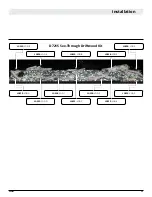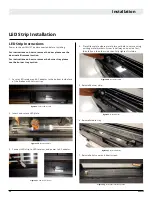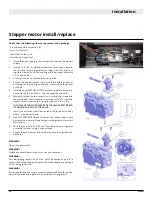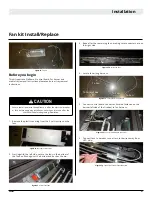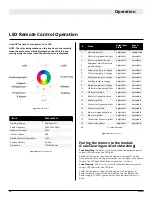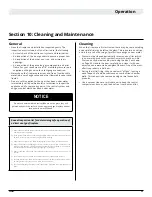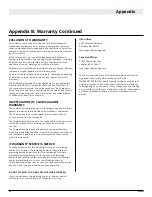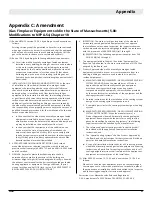
XG0222
49
Operation
General
• Have the fireplace and installation inspected yearly. The
inspection must include, but is not limited to, the following:
• A visual check of the entire vent system and termination.
• An inspection of the door gaskets to ensure a proper seal.
•
An inspection of the burner, vent run, and primary air
openings.
•
An inspection of the gas valve, gas components, and pilot
flame. For your convenience a 1/8" manifold pressure tap is
supplied on the gas valve for a test gauge connection.
• Always keep the fireplace area clear and free of combustible
materials, as well as gasoline and other flammable vapors and
liquids.
•
Do not use this appliance if any part has been under water.
Immediately call a qualified service technician to inspect the
appliance and to replace any part of the control system and
any gas control which has been under water.
Cleaning
When the fireplace is first activated, there may be some smoking
and a visible film may be left on the glass. This is a normal condition,
and is the result of burning of protective coatings on new metal.
•
Glass must be cleaned periodically to remove any film (which
is a normal by-product of combustion) which may be visible.
Film can easily be removed by removing the door, as shown
on Page 35. Handle the door carefully, and clean it with non-
abrasive, non-ammonia based glass cleaners. One of the most
effective products is Kel-Kem.
•
During the initial firing, Silicone seals will "off gas", leaving a
visual deposit of a white substance on combustion chamber
walls. This can easily be removed using normal household
products.
• Use a vacuum cleaner or whisk broom to keep the control
compartment, burner, and firebox free from dust and lint.
Section 10: Cleaning and Maintenance
Annual inspection list for determining safe operation of
a direct vent gas fireplace
1)
Inspect and operate the pressure relief mechanism to verify relief mechanisms are free
from obstruction to operate.
2)
Clean glass window with a suitable fireplace glass cleaner. Abrasive cleaners must not
be used. Be careful not to scratch the glass when cleaning.
3)
Inspect the operation of the flame safety system Pilot or Flame rectification device.
4)
Inspect and ensure the lighting of the main burner occurs within 4 seconds of the
main gas valve opening. Visual inspection should match that outlined in the appliance
instruction manual. Inspect primary air openings for blockage.
5)
Inspect condition of vent and vent terminal for sooting or obstruction and correct if
present.
6)
Vacuum and clean any debris in the firebox that is not supposed to be there.
7)
Test and measure the flame failure response time of the flame safety system. It must
de-energize the safety shutoff in no more than 30 seconds.
8)
Check all accessible gas-carrying tubes, connections, pipes and other components for
leaks.
Do not use ammonia or abrasive cleaners on the glass, they will
permanently etch the surface. Use an approved gas fireplace cleaner
such as Kel-Kem or White off.
NOTICE

